The following review of the Xiegu G90 originally appeared in the August 2020 issue of The Spectrum Monitor magazine:
A comprehensive review of the Xiegu G90 general coverage transceiver
My coming of age in the world of radio was during the era of big US and Japanese radio manufacturers. Icom, Kenwood, Yaesu, JRC, and Ten-Tec––these were the icons of my youth. And, I freely confess, I developed a partiality for their products.
So when incredibly inexpensive transceivers from manufacturers in China started showing up on the market a little over a decade ago, I was…well, skeptical. Very. Many of these radios were a fraction of the cost we had been paying, and some models looked like direct copies of radios that were already on the market…but these copies were all-too-often second-rate either in features or performance.
Thus, as it was my policy to invest in quality products, I continued to put my money toward US, Japanese, and European legacy manufacturers that I felt would be here for the long haul in the amateur radio and SWL communities.
Had I become a bit of a radio snob? I admit it…maybe I had. But in truth, I was simply waiting for a quality Chinese-made radio to come along and change my viewpoint.
Times have changed
Recently, I compiled a list of general coverage QRP transceivers for the SWLing Post. My buddy Eric (WD8RIF) pointed out that I neglected to include any of the Chinese-made Xiegu brand transceivers, all of which offer general-coverage receiving.
I know a number of hams who use Xiegu (pronounced roughly “SHEH-goo”) brand portable transceivers for Parks On The Air (POTA) and Summits On The Air (SOTA) activations, and like them very well. So I decided to waive my doubts and check out Xiegu’s transceivers. I found myself intrigued with one in particular: the G90.
The Xiegu G90
At time of publication, there are three Xiegu models widely available: the G1M, X5105, and the G90.
The GM1 ($260) is a compact, four-band 5-watt QRP transceiver, while the X5101 ($520) is a 160M-6M 5-watt Double Conversion Superheterodyne QRP transceiver. Both look promising, but the G90 is a 20-watt 160M-10M transceiver sporting a 24-bit 48 kb/s sampling analog-to-digital/digital-to-analog converter at just $450. That’s the one I chose to investigate.
I found both the G90 receiver specs and 20-watt-output power very appealing, especially considering the modest $450 price tag. But I found this receiver has other impressive features:
- Detachable faceplate with included separation cable
- Full-color backlit display with both spectrum and waterfall
- Built-in side panel extensions to protect the front face and back of the radio
- General coverage receiver (0.5~30MHz) in SSB/CW/AM
- Built-in automatic antenna tuner (ATU)
About the only feature the G20 doesn’t include is an option for a built-in battery pack. Certainly not a deal-breaker by any means, since more often than not I use an external LiFePo battery for field-portable radio work.
I made up my mind to bite the bullet and purchase the G90. I was incredibly curious whether it could compete with my Elecraft KX3 and/or KX2, and I also wanted to explore the capabilities of its general coverage receiver for broadcast listening.
I placed an order with US distributor MFJ Enterprises for a total cost––including shipping––of $467.95.
Initial impressions
I tend to review ham radio transceivers around the time they hit the market. One of the unique advantages of being one of the first people to review a transceiver is that I really have no idea what to expect in terms of performance, other than perhaps what the manufacturer’s reputation has taught me over the years. And if the manufacturer is fairly new to me––? Then it’s truly a roll of the dice.
The G90, however, had been on the market for quite a few months, so I simply avoided reading any in-depth reviews so I could form my own opinions. With that said, I knew in advance that this radio is already well-loved by a very active and enthusiastic community of amateur radio operators. So I had only to make up my mind, myself. I got to work.
Form-factor
When I first removed the G90 from its box, I was struck by its weight, build quality, and size. First off, it’s a heavy little radio. The Xiegu site notes that the weight of the radio is about 2.2 lbs (1 kg), but perhaps due to its compact size, it felt heavier to me. Indeed, when I placed it on my postal scales, it came in closer to 3 lbs 10 oz. Still a very reasonable weight for a portable radio, but a bit heavier than described.
Speaking of size, the G90’s shape is pretty unique. Looking at the radio head-on, it’s reminiscent of most portable QRP transceivers (like the CommRadio CTX-10 or Yaesu FT-818, for example) meaning that the front face is compact. The depth of the radio, though (or length, depending on how you look at it), is about 8.3 inches––or nearly 10” if you include the side panels––equivalent to many of my 100 watt radios.
The build quality of the G90 is truly impressive. Holding it in your hand, you feel like you’ve acquired a quality piece of kit. The chassis is very durable, the buttons have a tactile response, and both the front and rear are protected by built-in side panels (typically side panels would be a third-party addition for most radios).
Audio
Audio from the internal speaker, which is mounted on the top of the radio, is loud and punchy, a desirable attribute for a field radio. Better yet, when you port the audio to an external amplified speaker (headphone jack is on the left side of the radio head), fidelity is quite good. The audio and noise floor, to my ear, is rougher than that of pricier QRP transceivers.
Display
The color TFT LCD screen measures only 1.8,” one of the smallest I’ve ever tested on a radio, but Xiegu did an admirable job laying out the interface so that it’s easy to read at any viewing angle. If you wear reading glasses to read a book, you’ll need them to read this display––some of the numbers and labels are tiny, but very sharp, crisp, and high contrast. I’ve had no difficulty whatsoever reading the display in the field.
What’s more, the spectrum display and waterfall are responsive and in real-time––there’s no delay or averaging which I especially appreciate when chasing CW and SSB signals. Although at first blush one might think the spectrum and waterfall are just too small to be useful, that would be a mistake. I was guilty of this prejudice myself, and now find I rely on the spectrum display to help locate unused frequencies, spot someone calling CQ, and even identify the relative proximity of an adjacent signal. Truly a helpful feature.
Bail
Unfortunately, there’s one very conspicuous omission on the part of the G90 designers: it has no bail nor feet of any sort to support the front of the radio and angle it for ergonomic operation. Herein lies my biggest criticism of this radio, because it truly needs something to prop up the front of the radio for comfortable operation, not to mention, to allow the bottom of the radio to dissipate heat effectively.
There are a number of third-party producers that will supply a bail for the G90, but many are clunky and expensive, and I feel an attached/integrated bail is always best.
Ad hoc solutions to the fore: in the field, I simply prop the G90 on my
Bioenno 15 aH LiFePo battery; in the shack, I use a small support stand I purchased for my Elecraft KX3. Not as good as a purpose-made bail, but this works.
Microphone
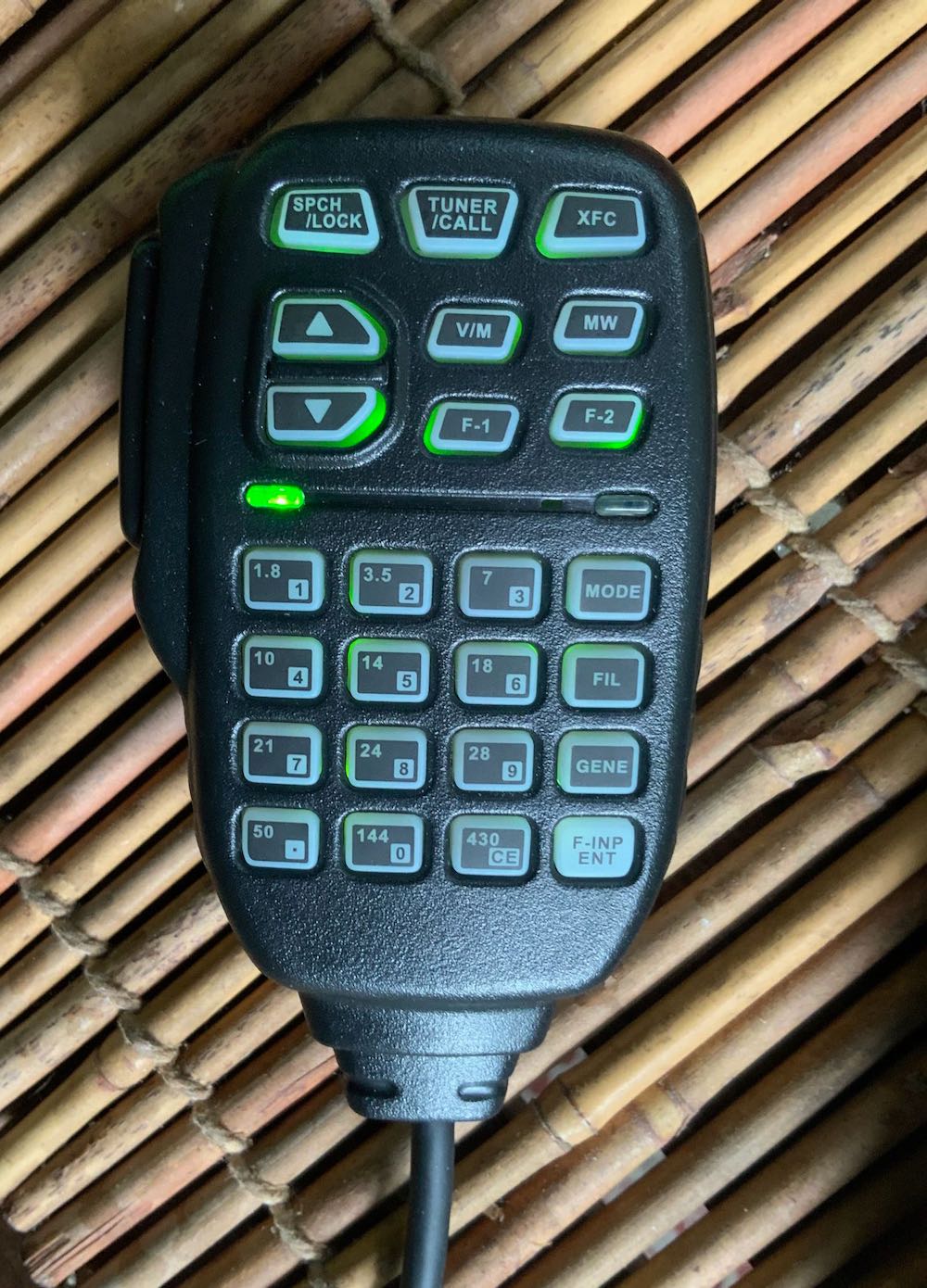 The microphone that accompanies the G90 is what you would expect from a mobile HF rig: almost all functions can be controlled by its backlit keypad. I have read a few reports of people dropping and breaking the supplied mic. Turns out, the Mic’s 8-Pin Modular Plug is configured like a number of Icom radio models, and a replacement mic can be purchased on Amazon for about $22.
The microphone that accompanies the G90 is what you would expect from a mobile HF rig: almost all functions can be controlled by its backlit keypad. I have read a few reports of people dropping and breaking the supplied mic. Turns out, the Mic’s 8-Pin Modular Plug is configured like a number of Icom radio models, and a replacement mic can be purchased on Amazon for about $22.
Remote head
As mentioned earlier, the control head of the G90 can also be separated from the body for use in mobile applications such as a car, RV, or even in the shack. The real surprise here is that the separation cable is included in the package. I’m not sure I’ve ever owned a mobile radio that came with a separation cable––what a luxury! Great addition.
Internal ATU
Another surprise for a radio in this price class: the G90 has a built-in automatic antenna tuner (ATU). When I first made the decision to purchase and review the G90, I didn’t realize this, and in fact would have never guessed it to be a possibility in a $450 transceiver. What’s more, this ATU is one of the best I’ve ever used in the field: it’s quick to match, and seems to find a match with almost any setup. I almost wish Xiegu sold a stand-alone portable ATU so I could use it with my other radios that lack an internal ATU.
Power output
Unlike most of the portable transceivers on the market that have maximum output power of around 5-15 watts, the Xiegu G90 will pump out up to 20 watts. While 90% of all of my ham radio communications are accomplished at 10 watts or below, I’ve appreciated a little extra “juice” while operating in the field.
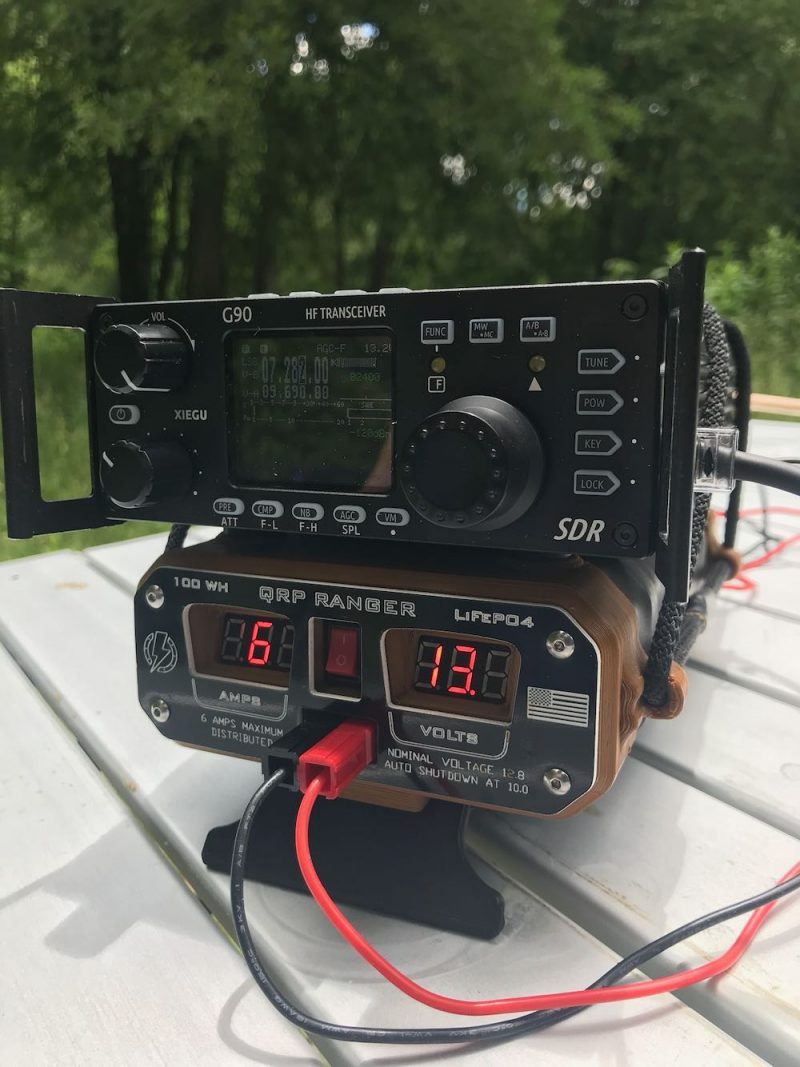
Note: due to the speed of my phone camera, not all of the LED segments of my battery pack are visible.
With all that’s packed into this transceiver, no wonder it’s a heavy little unit!
My conclusion here is that the G90 feels like a quality rig. But how does it perform? Let’s first take a look at how I evaluate the transceiver as a ham radio operator, then as a broadcast listener and SWL.
Ham Radio Operation
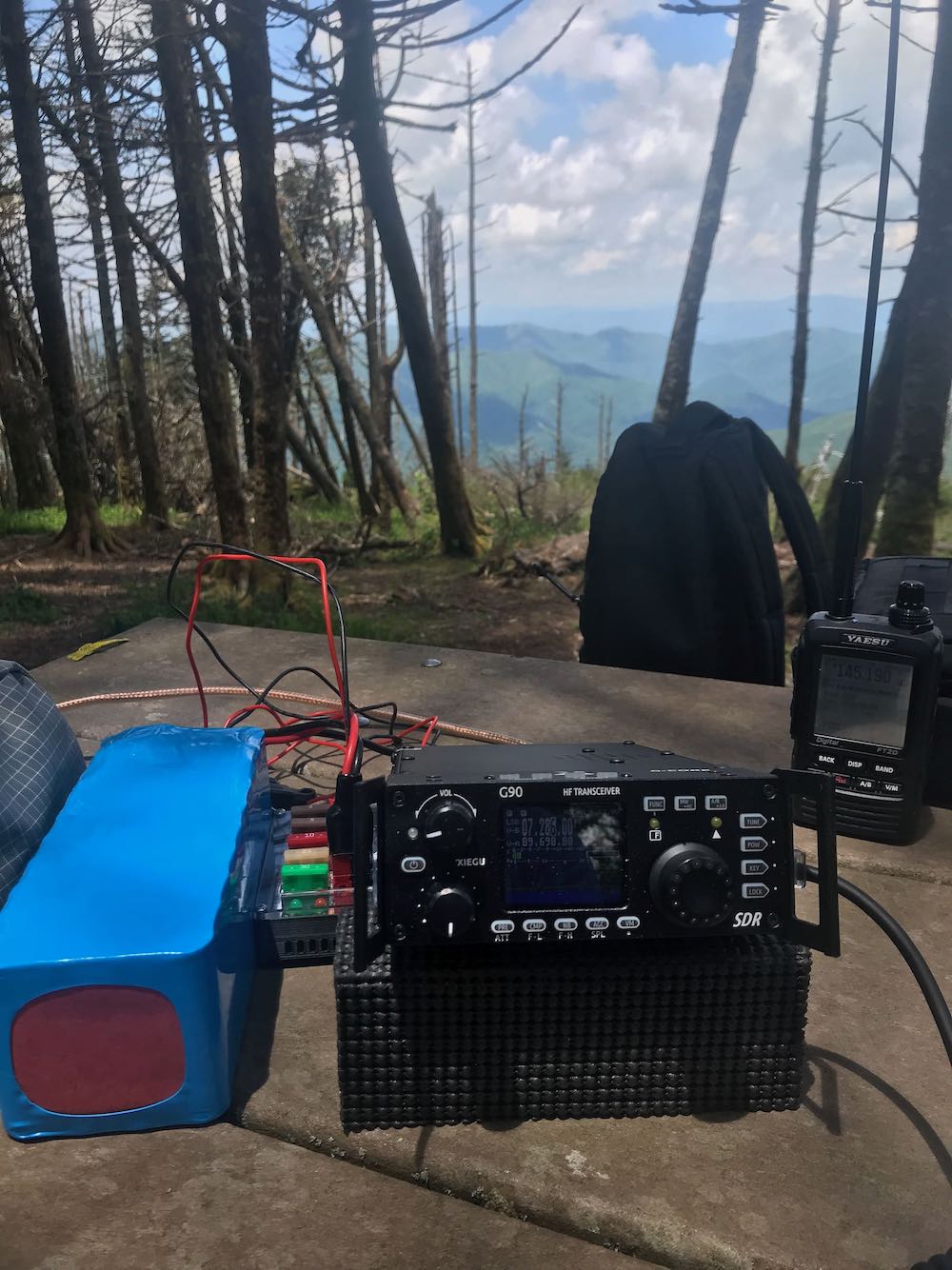 Over one month of operating the G90, most of that time has been in the field, as I’ve taken the radio along for a number of Parks On The Air (POTA) field activations. Although I’ll be commenting about the G90’s performance as a transceiver in general, keep in mind that I do so mainly through the eyes of a field operator.
Over one month of operating the G90, most of that time has been in the field, as I’ve taken the radio along for a number of Parks On The Air (POTA) field activations. Although I’ll be commenting about the G90’s performance as a transceiver in general, keep in mind that I do so mainly through the eyes of a field operator.
Although I often dislike operating compact radios due to small buttons and complex embedded menus that supply knobs and buttons with multiple duties, I find operating the G90 surprisingly pleasant. All of the most important functions of the transceiver can be called up with one or two button presses. Obviously, a real ham radio operator played a part in designing the G90’s operation.
Tuning the G90 is a simple process. The main encoder, of course, allows you to tune up/down the band. By short-pressing the encoder knob, you can change between the hundreds, tens, ones, tenths, and one-hundredths of a kHz. In fact, it’s very simple to move around a band this way. The encoder action is defined by detents that you feel as you rotate the knob. Normally I’m not a fan of detents on a radio’s main encoder knob, but since this one is so small, I think I actually prefer it as a means to control the spinning action. There is no brake adjustment.
The supplied encoder knob is made of plastic and has dimples on the front to give your finger a bit of grip as you tune up or down. Upon the recommendation of a friend, I purchased a third-party dimpled aluminum knob to replace it––a major upgrade for a modest $8 investment!
Changing between bands and modes is very simple with the G90. There are dedicated band and mode up/down buttons on top of the radio’s front panel much like those on the venerable Yaesu FT-817 and 818 series. The G90 defaults to ham radio band allocations, but there is a menu setting that allows you to also include broadcast bands between band changes. Nice touch.
There is a dedicated AF gain control on the front of the radio. After receiving the radio, I was disappointed by the lack of an RF gain control, something I use a lot during noisy band conditions. Fortunately, Xiegu included an RF Gain control in one of the latest firmware updates: to access it, simply press and hold the AGC button, then make adjustments to the RF Gain percentage with the main encoder. The G90 defaults to a 50% setting. While I’m not really sure what this setting means, I do find the RF gain control quite effective, even though it doesn’t respond like a legacy receiver’s RF gain control.
The Xiegu G90 has a simple and effective variable-filter control: simply press the FUNC button then the CMP button, and use the encoder to adjust the low end of the filter. To adjust the high end, press the FUNC and NB button in the same way. I love the fact that the filter can be adjusted from both the high and low ends, and that it’s variable instead of set at predetermined fixed widths such as “wide” and “narrow.” All mode filters are adjusted in this fashion.
CW Mode
The G90 is a capable CW transceiver and should please the CW operator. The keyer speed, ratio, auto modes, and paddle setup are all accessible from the KEY function button. By pressing the FUNC and Key buttons, you can access the CW volume and tone parameters. The G90 also allows you to turn on a QSK function and adjust the hang time. The G90’s version of QSK isn’t the full-break-in variety you might find in, say, the Elecraft KX series radios. Meaning, while the hang time is very short, if sending at high speed you won’t be able to hear another station break in between your characters. You will note a slight relay click. With that said, I find the QSK mode to be quite effective for my use because I’m not really a “full-break-in” kind of operator.
Speaking of CW, the G90 features a CW tune feature that indicates when you’ve locked onto a CW signal: a yellow LED will flash as CW is received. While I find this feature a bit distracting, I’m sure some operators will appreciate it. In addition, the G90 features a CW reader that will decode CW when a station is properly tuned in and isolated from others.
In the field, this feature has helped me confirm call signs––but like most transceiver CW readers, it’s not always accurate, especially if the CW operator on the other end uses a hand key or bug. Still: a welcome feature.
SSB mode
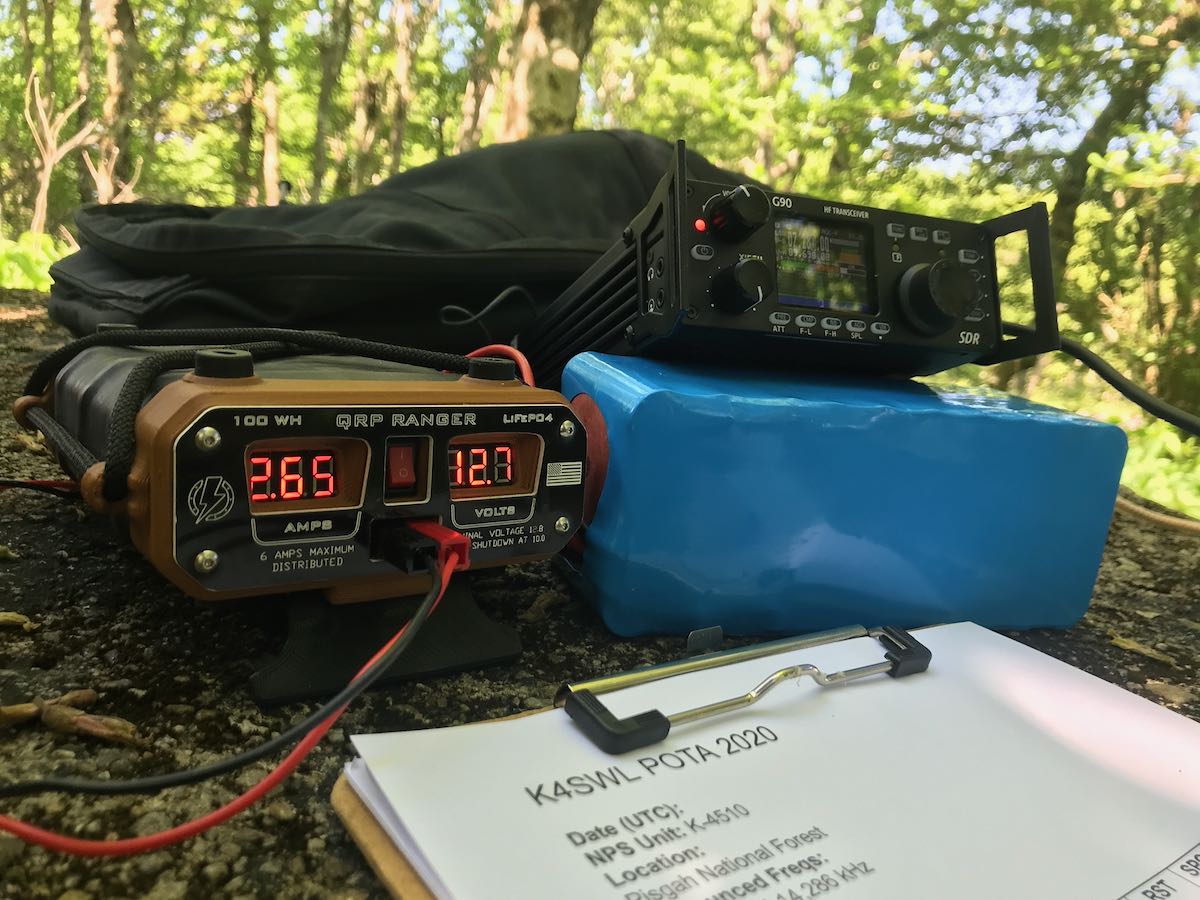 Most of my operating time on the G90 has been in SSB mode, and I’ve been very pleased with the radio’s performance in this mode. The G90 allows you to adjust the mic gain and enable compression. I’ve gotten excellent audio reports from the numerous SSB contacts I’ve made on the G90.
Most of my operating time on the G90 has been in SSB mode, and I’ve been very pleased with the radio’s performance in this mode. The G90 allows you to adjust the mic gain and enable compression. I’ve gotten excellent audio reports from the numerous SSB contacts I’ve made on the G90.
I should note here that although I feel you get much more radio than you pay for with the G90, I do wish it had a voice keyer. Especially when I’m activating a park via POTA, I call CQ a lot. With my Elecraft KX3 and KX2, for example, I set the voice keyer to “beacon” mode which allows me to pre-record a CQ and have it playback the message on a loop with a few seconds in between to allow me to recognize anyone replying to my call. I rely so heavily on this feature for SSB park activations, just to save my voice, I know the G90 can never displace my Elecraft field radios. Again, I wouldn’t expect such a feature in this price class, but it would make for a near ideal field radio.
Digital modes
One thing that surprised me about the G90––especially since it is an SDR––is that operating digital modes is less “native” than I would have expected. Many modern SDR transceivers make setting up for modes like FT8 relatively easy with both CAT control and often the radio itself is identified as a sound card, thus no external interface is needed. When I decided to try running FT8 on the G90, I was discouraged by the fact that setup is much more like that of a legacy radio. Indeed, many users have had communication issues with popular software packages.
Since I wanted to test the G90 as a field radio and since I do very little FT8 in the field, I simply omitted testing this functionality. I have read that many operators have, of course, been able to successfully use the G90 for digital modes, but be prepared to read through the G90 email discussion group (see link at end of article) for best practices.
Update: SWLing Post contributor, David White, brings up one fine point about the G90’s VOX control. “I use that feature for TX control when running any of the digital modes with the laptop audio in/out going through the rear AUX connection.” Thanks for pointing this out, David. VOX control really facilitates using digital modes because the radio can detect audio comping from the computer and engage transmit without having to use CAT control of any sort.
Receiver Performance
Overall, I’m favorably impressed with the G90’s receiver. Both sensitivity and selectivity are above par, especially for a radio in this price class. The G90’s noise floor is acceptable, though not as low as that of my Elecraft radios. I do find that with the G90, I often need to ride the RF gain control in our noisy summer band conditions. I find that by adjusting the RF Gain and selecting the most effective AGC setting, I’m able to achieve an excellent signal-to-noise ratio. I find the G90 audio a bit fatiguing when I’m operating for long periods of time–at least, compared to some of my other transceivers.
In a nutshell: the G90 packs a lot of performance in an affordable radio, especially if you’re willing to tailor the filter settings, AGC, and RF gain to best accommodate the conditions.
Field notes
I’ve been very pleased with how long I can operate on battery power with the G90. Even with the display backlit set to 80% and with the volume set to high, I found that the maximum amperage the G90 would consume was about 0.60 amps. While I wouldn’t consider that benchmark, it is respectable.
I also like the G90’s built-in antenna analyzer. By pressing and holding the POW button, the G90 will display a graph showing the SWR figures across your specified frequency range. A brilliant and handy feature in the field! It’s important to note, though, that during the test the radio is transmitting a little RF so don’t try it with a receive-only antenna.
I do find that the G90’s body gets pretty warm–downright hot–when activating a park. It’s no wonder, really, because I often end up calling CQ at five second intervals over the course of 60-90 minutes on average. That’s demanding a lot of a fanless radio, thus it gets very warm to the touch. Still, while I never had any overheating issues, I’ve also never operated the radio in direct sunlight for extended periods of time and I’ve always propped up the radio so that air can flow underneath the chassis. Again, if for no other reason than to dissipate heat, Xiegu should have incorporated a bail or folding feet. As much as I love the front and back panel extension, I would have chosen a bail over these.
Broadcast listening
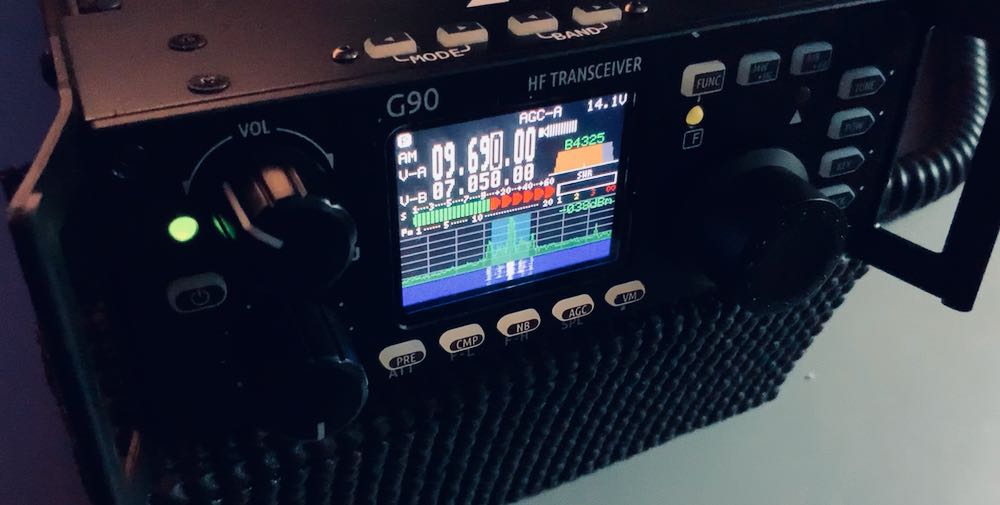 While broadcast listening is often an afterthought for most ham radio operators, it never is for me. I like to travel lightly and I like my QRP transceiver to double-duty as a tool for SWLing.
While broadcast listening is often an afterthought for most ham radio operators, it never is for me. I like to travel lightly and I like my QRP transceiver to double-duty as a tool for SWLing.
From day one, I have spent a great deal of time with the G90 across the broadcast bands.
Shortwave
One of the main reasons I decided to review the Xiegu G90 is because I found so little information out there about how well the general coverage receiver worked for HF broadcast listening. The G90 has a frequency range of 0.5-30 MHz (SSB, CW, and AM).
But I couldn’t find a specification showing the maximum width of the AM filter. In a few display photos with the AM filter width was indicated as 5.4 kHz––if this was so, I concluded, it was fairly workable if not particularly wide. However, only moments after opening the box and putting the G90 on the air, I tuned to the Voice of Greece (9,420 kHz) and learned how to change the AM bandwidth. I was very pleased to find that in AM mode, that indicated filter width is only half the actual width: this means the G90’s AM filter can actually be widened to 10.8 kHz––brilliant!
In short, I’ve been very pleased using the G90 for shortwave broadcast listening; it has exceeded my expectations. I find that in terms of both sensitivity and selectivity, it offers performance on par with a dedicated receiver.
For an idea of how the G90 sounds on shortwave with its internal speaker only, check out the following videos:
The Voice of Greece
Radio Nacional De España
Broadcast listening is basic with general coverage transceivers: the G90 has no synchronous detector with selectable sidebands, for example. G90 users have requested this feature in a future firmware update, but I wouldn’t hold my breath in anticipation. I imagine G90 developers will be more concerned with ham radio-specific functionality.
Mediumwave
Let’s face it: Asking the G90 or any ham radio transceiver to perform on the mediumwave/AM broadcast band is asking it to do something it was never designed to do.
With that said, I have been very pleased with the G90 on the AM broadcast band.
Audio fidelity is excellent, especially with the AM filter widened appropriately and when using an external speaker or headphones.
The G90 performs so well between about 900-1700 kHz, I have even done some proper mediumwave DXing with it.
Below 900 kHz, I’m still able to tune strong and weak stations, but I have found some odd behavior with imaging as I tuned down to 500 kHz: some stations would move across the spectrum display in the opposite direction to which I was moving the encoder. I suspect this may be due to a very strong local station near me on 1010 kHz that was overloading the front end.
Again, however, I never expected any reasonable performance on mediumwave–especially since many transceiver manufacturers intentionally attenuate those frequencies, so I’ll accept any quirks it may have here and consider any G90 mediumwave functionality at all simply icing on the cake.
Important caveat for the broadcast listener
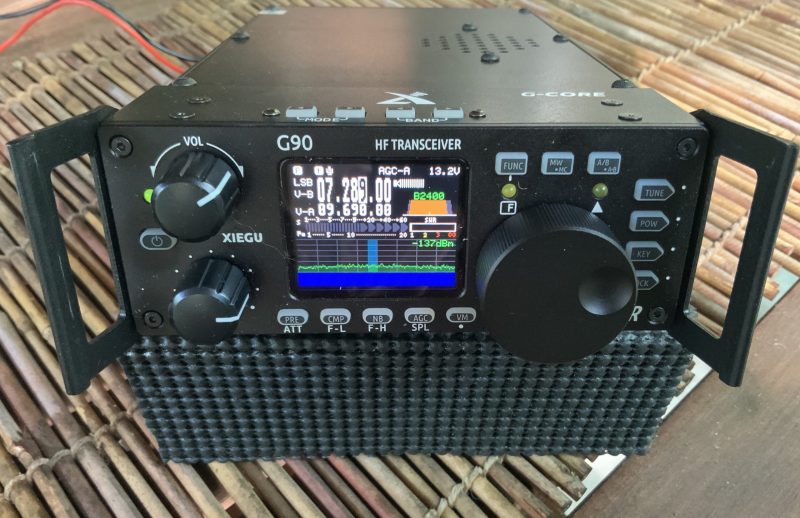 While, overall, I’ve been super pleased listening to the shortwave and mediumwave with the G90, there is (at time of publishing) a major drawback for anyone who would like to use the G90 exclusively as a stand-alone receiver: there is no way to completely disable the transmitter.
While, overall, I’ve been super pleased listening to the shortwave and mediumwave with the G90, there is (at time of publishing) a major drawback for anyone who would like to use the G90 exclusively as a stand-alone receiver: there is no way to completely disable the transmitter.
The lowest power setting on the G90 is 1 watt. While that’s not a lot, it’s more than enough to fry your amplified magnetic loop antenna, for example. So, please use caution.
Although you could make it more difficult to transmit by not hooking up the microphone or a key (of course), there’s no way to disengage the internal ATU. If you accidentally press and hold the TUN button, it will engage the ATU and transmit.
In addition, if you press and hold the POW button, you will engage the antenna analyser function which will also inject RF as it sweeps across the bands testing the antenna’s standing-wave ratio.
Based on a suggestion, I even tried setting up the G90 in split mode with the transmit frequency set well outside the meter band I was operating. I thought by having the transmit frequency out-of-band, it would keep the radio from transmitting. Turns out, I discovered a bug in the G90. When you perform this procedure, it essentially bypasses the safeguards that keep an operator from transmitting out-of-band. Since this is public now, I assume it will be addressed in a future firmware update.
And, as careful as I am as an operator, I would never hook my G90 up to an active receiving antenna for this very reason. While I’m sure there’s probably a hardware modification to kill the transmitter section on the G90, it would be brilliant if Xiegu developers include a function via a firmware update to snuff transmit. At the very least, perhaps they could devise a way to disengage the ATU and antenna analyser functions via firmware.
Summary
Every radio has its pros and cons. When I begin a review of a radio, I take notes from the very beginning so that I don’t forget my initial impressions and observations. Here’s the G90’s list, from the first moments I turned it on to the time of writing this review:
Pros:
- Amazing “bang-for-buck”––a lot of radio for the money
- Crisp, easy-to-read backlit color display
- Detachable control head, cables included
- Built-in side panel protection for head and back
- AM broadcast listening
- Excellent shortwave reception
- Capable mediumwave performance
- 20 watts power output
- Mic can control all-important radio functions, including direct frequency entry
- Very good audio from internal speaker
Cons:
- No built-in bail
- No manual or auto notch filter
- Very few options for customizing the display
- (Minor) Firmware updates must be made to faceplate and transceiver body separately
- MW: some weird functionality below 800-900 kHz (eg, images in opposite direction)
- No voice keyer
- No CW memory keyer
- No internal battery option
- Cannot lower power output below 1 watt, cannot disable transmit
- Bottom of chassis gets hot during prolonged periods of operation
- ARRL and Sherwood testing shows key clicks in transmit
- Received audio a bit fatiguing over long listening sessions
Conclusion
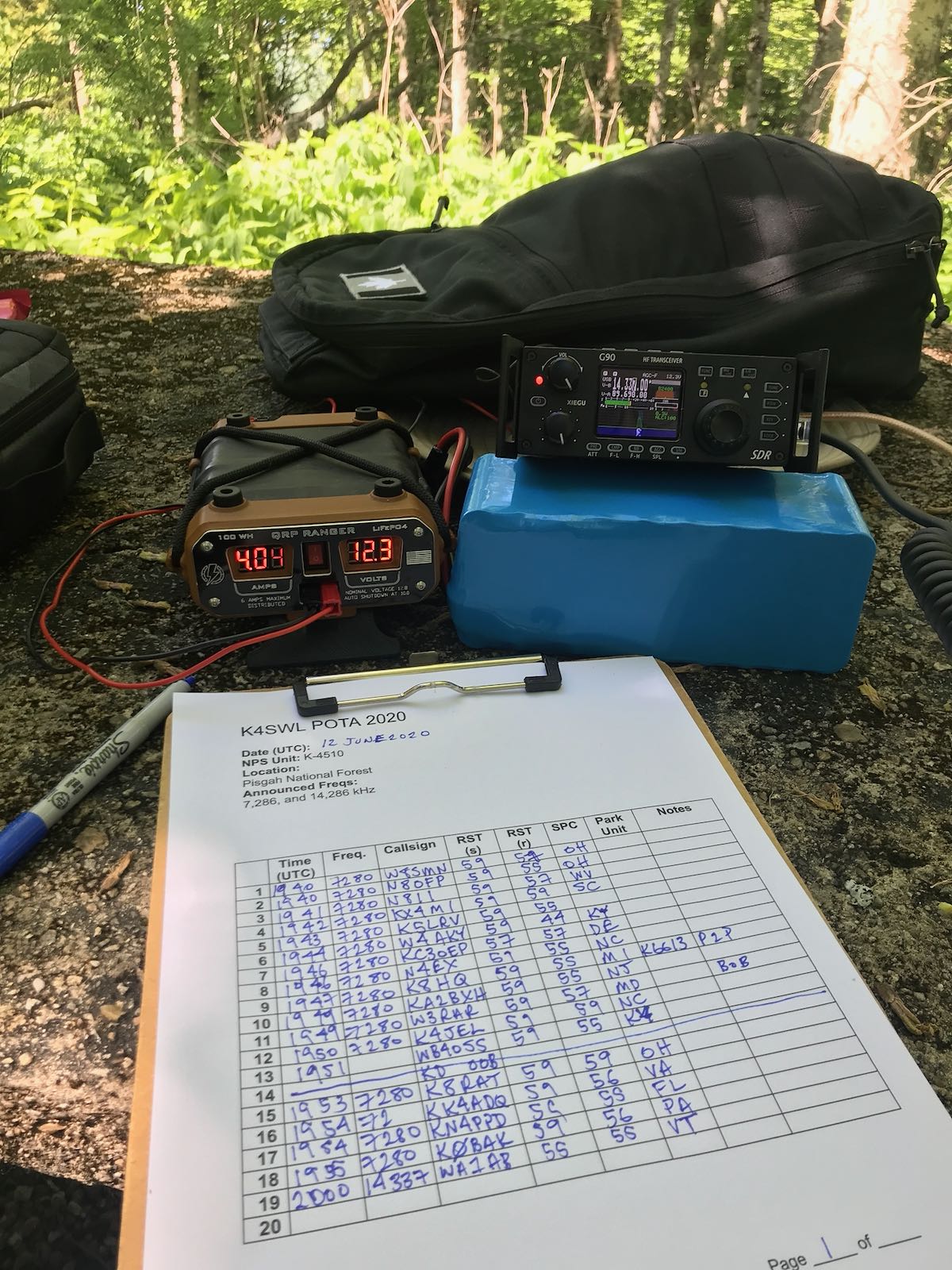 Despite the shortcomings above, I have to say: the Xiegu G90 has exceeded my expectations, and then some.
Despite the shortcomings above, I have to say: the Xiegu G90 has exceeded my expectations, and then some.
Without a doubt, the G90 is a solid radio and a steal at $450 US. If you’ve always wanted a field-friendly portable transceiver, but didn’t want to shell out a lot of money, you can buy the Xiegu G90 for the same price you might pay for a two year-old iPhone. Impressive.
Although the G90 is a budget radio, it doesn’t play like one. Performance is on par with a radio twice its price and not only does it pack a lot of extras––like an internal ATU, mobile-worthy control microphone and detachable faceplate––those extras actually work just as they should. Nothing about this radio feels “cheap.” In fact, I’d be more inclined to call it a little workhorse of a radio.
To answer a question I asked myself early in this process: will the G90 displace my Elecraft KX2 as my field radio of choice? No, but that’s because I already own the KX2 and find that it fits my operating style better than any other transceiver I’ve owned thus far. Yes, I still prefer the KX2’s operation, performance and versatility over that of the G90–it’s more refined–but the former is more than twice the price when similarly configured.
I think the G90 would also make for a stellar beginner’s radio, as it is a totally self-contained station; simply apply power, and play!
In short, I’m pleased to report that I’ve finally found a very affordable radio that’s a basic solid performer, and I look forward to further offerings from Xiegu.
Resources
- Groups.io Discussion Forum: https://xiegug90.groups.io/g/main
- Third Party Aluminum Encoder:
- eBay @ $7.90 US shipped
- Amazon.com @ $8.40 shipped (affiliate links)
Retailers
- MFJ Enterprises: https://mfjenterprises.com/products/xg90
- Amazon.com: https://amzn.to/3nYEBYu (affiliate link)
- Connect Systems: http://www.connectsystems.com/products/top/radios/G90.htm
- Ham Radio Outlet: https://www.hamradio.com/detail.cfm?pid=H0-016772
- Radioddity: https://www.radioddity.com/products/xiegu-g90-hf-transceiver
- Xiegu.eu: https://xiegu.eu/product/xiegu-g90-hf-20w-sdr-transceiver/
- eBay (click here to search–partner link)
Do you enjoy the SWLing Post?
Please consider supporting us via Patreon or our Coffee Fund!
Your support makes articles like this one possible. Thank you!

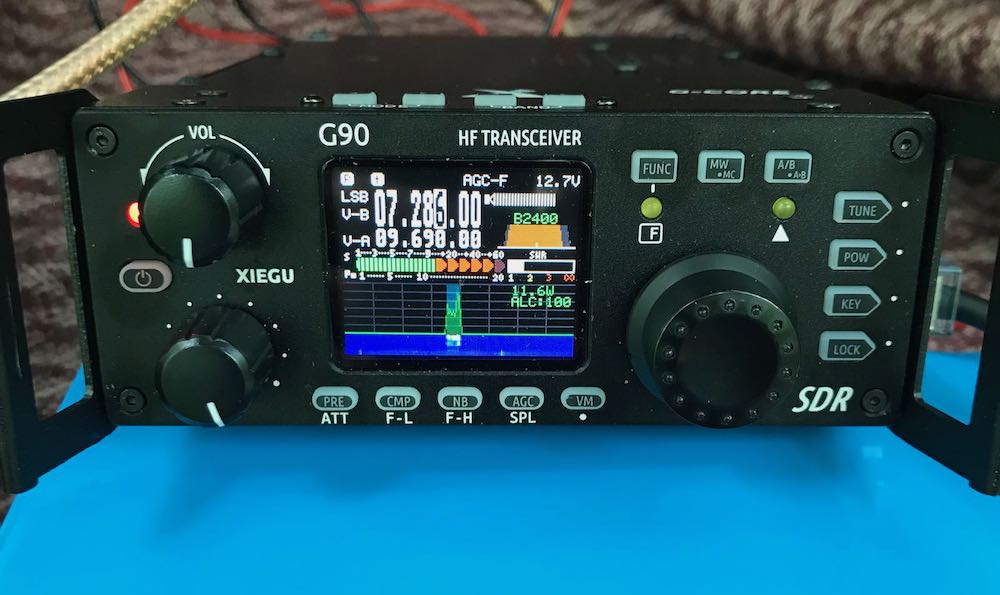
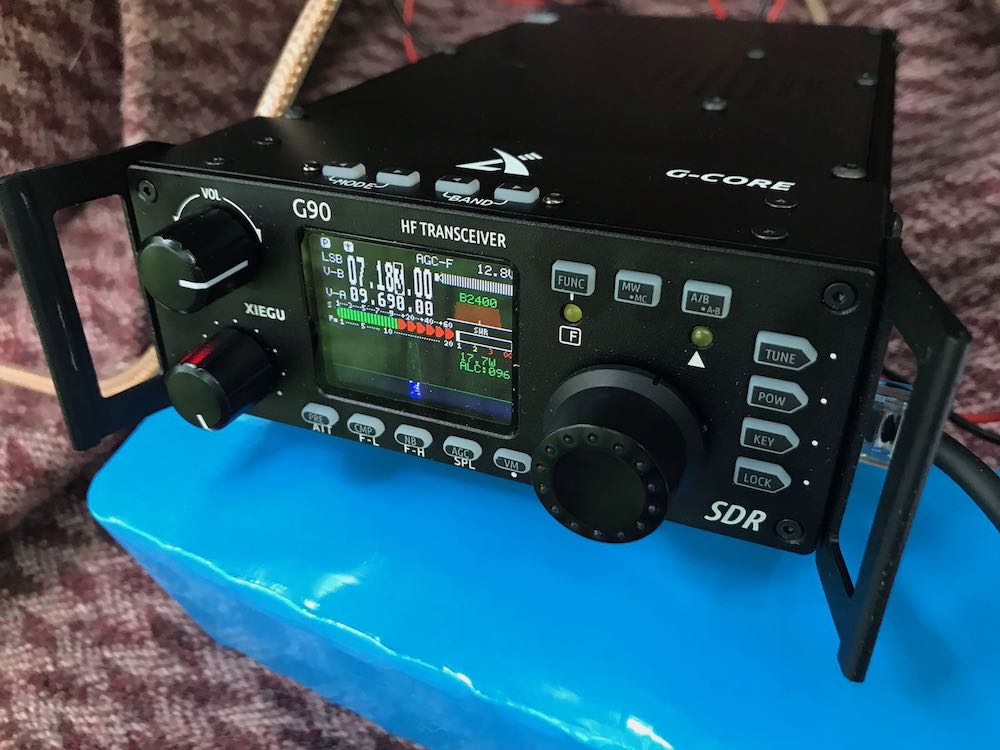
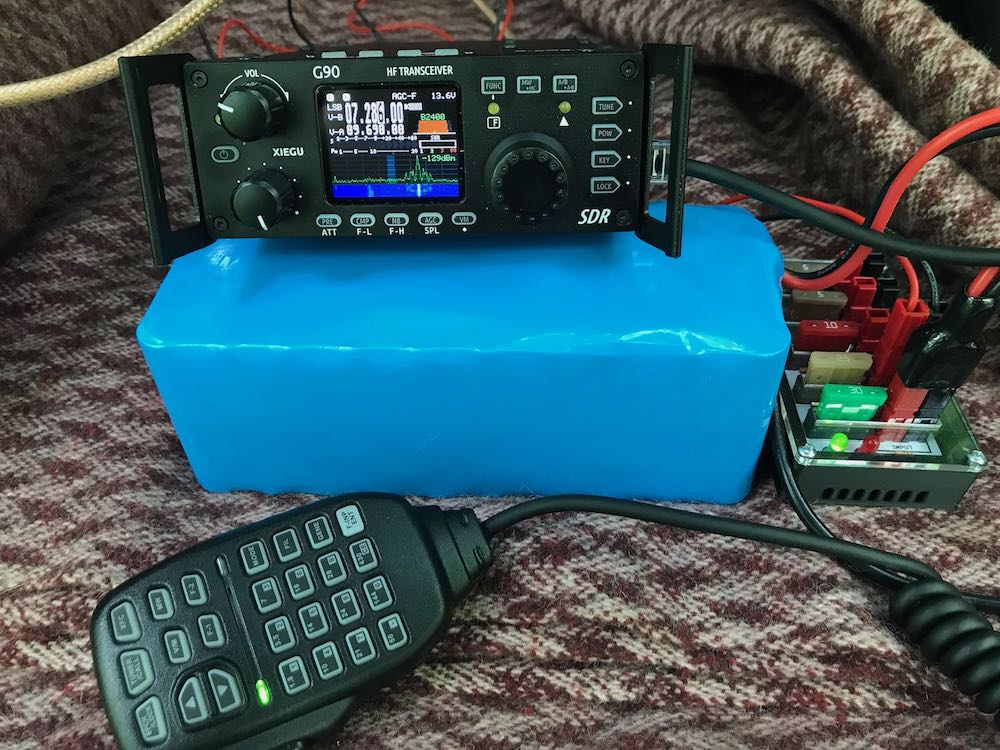
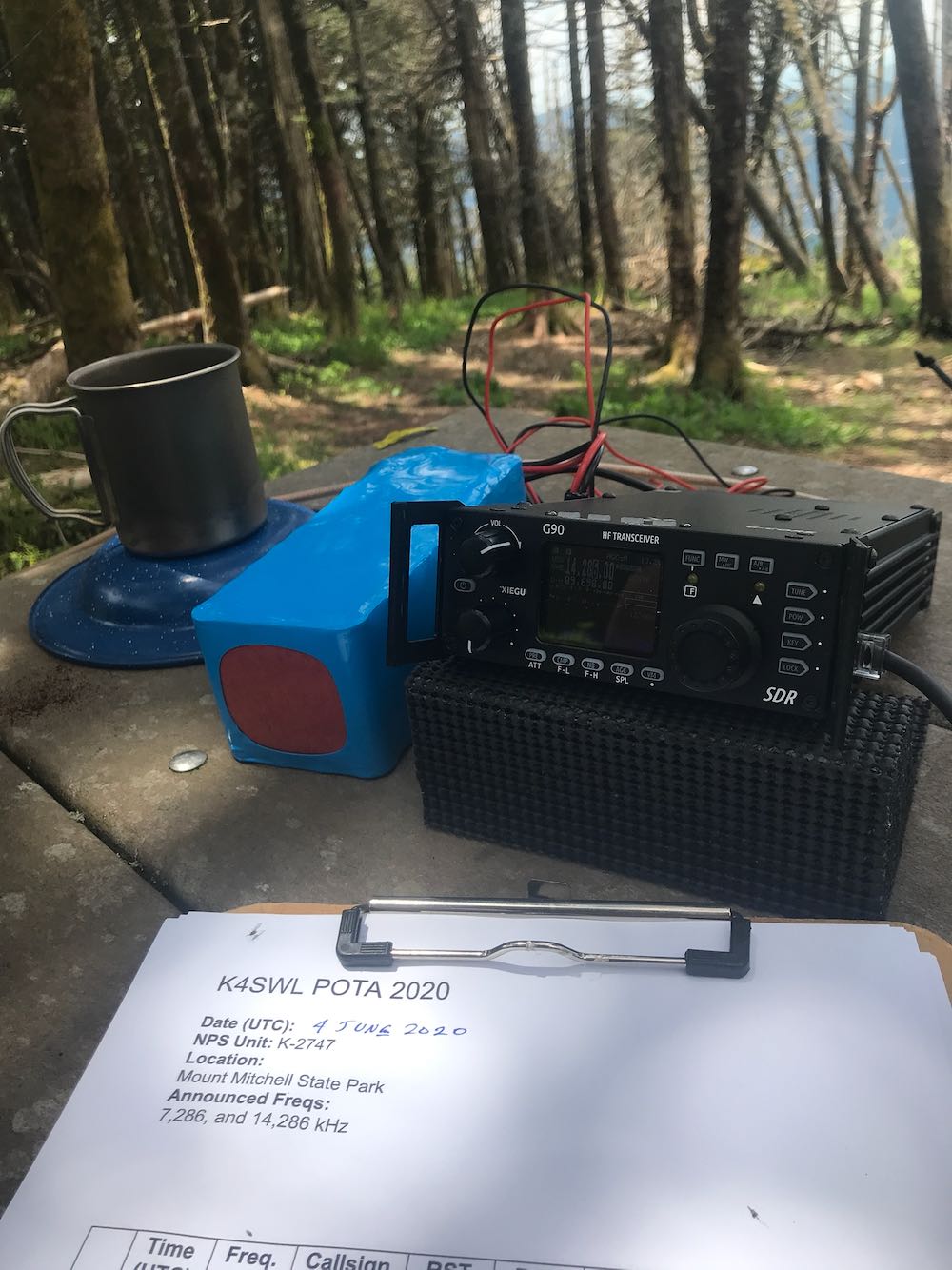
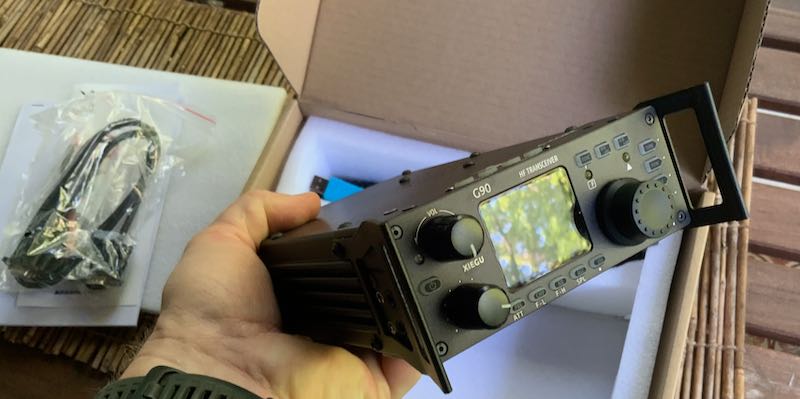
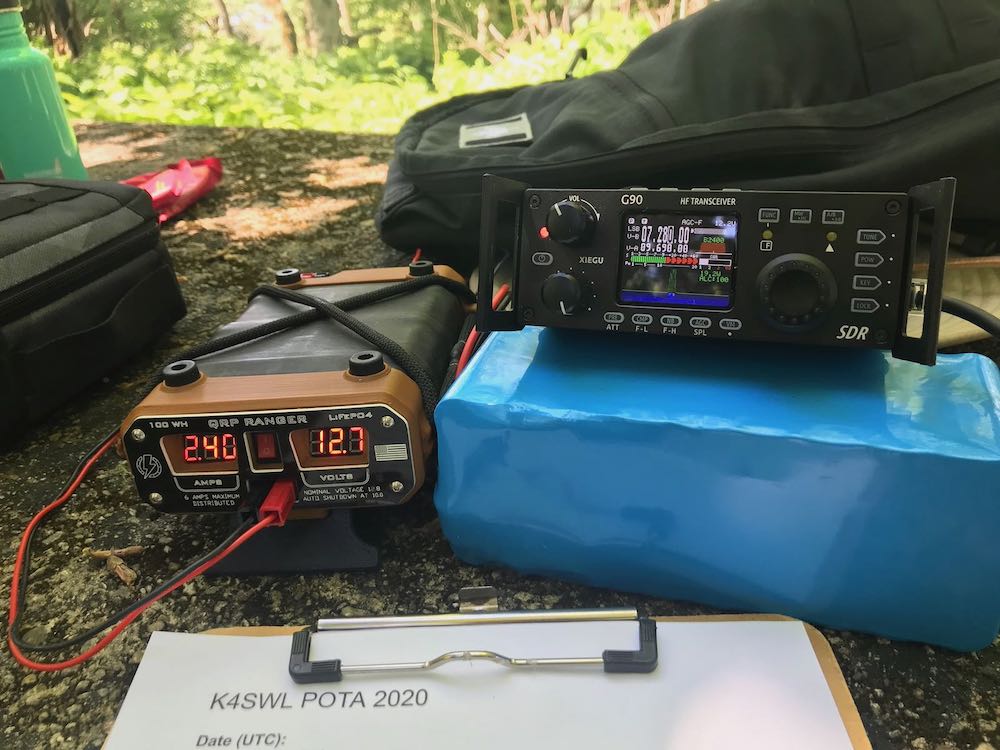
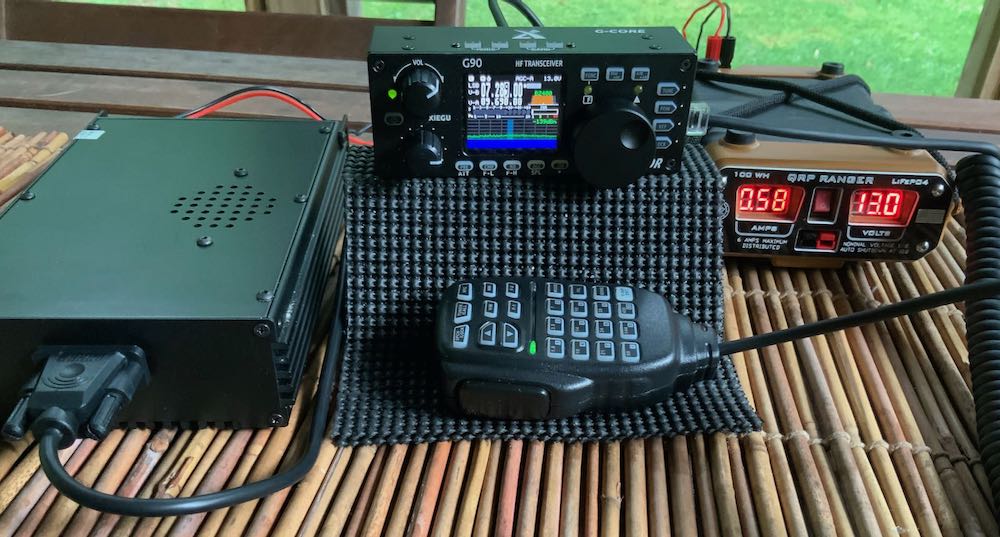
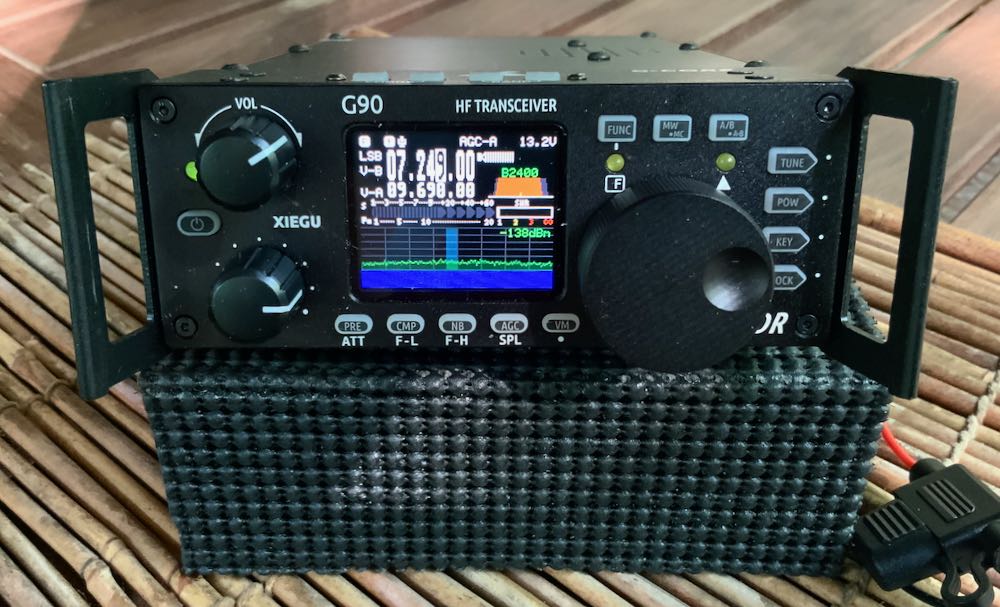
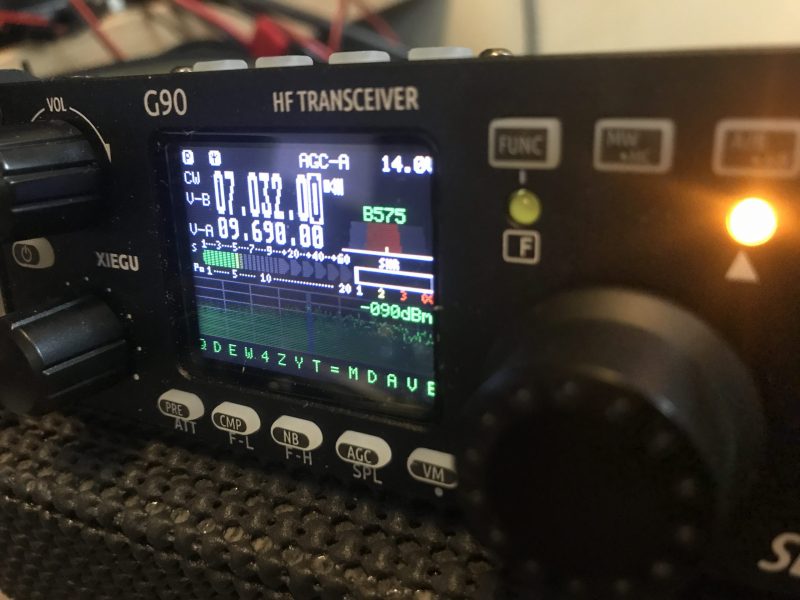
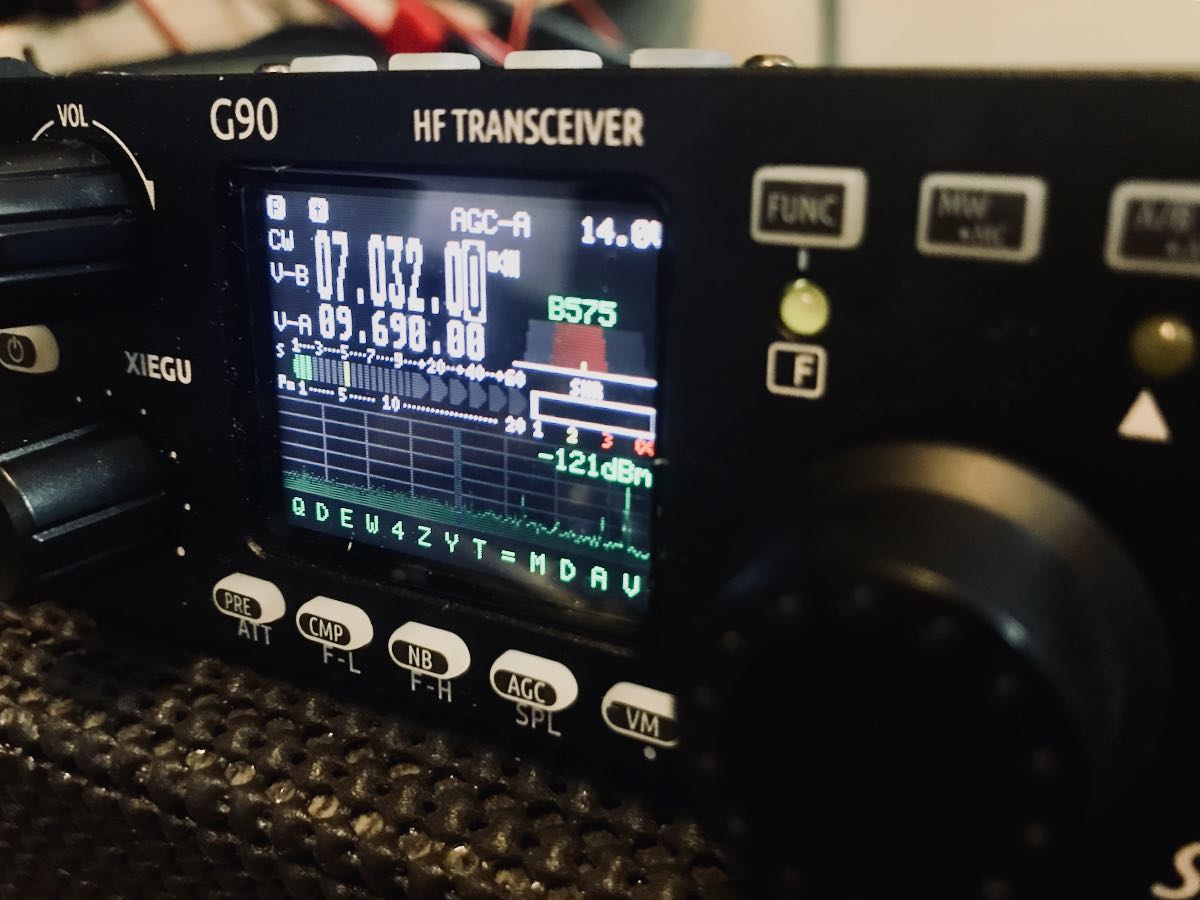

I love my G90! It’s perfect for POTA. In my experience, the 20w is the sweet spot for portable SSB – an ideal combination of ability to get out (while 5w is possible, it’s generally a slog) and small battery requirements. With 20w, I’ve had lots of delightful SSB DX chit-chats and even have broken DX pileups with SSB during the most recent CQ SSB DX contest.
As for antenna, I’m a huge fan of a JPC-12 vertical with a small base from DX Engineering and a 17-foot whip. While the JPC comes with a coil for 40M and 30M, I generally just use it sans coil and just pace off the 17-foot whip to a quarter of the desired wavelength. As I I detest messing with putting antennas in trees (that often aren’t high enuf to be effective anyway), the self-supporting antenna is great. Also, I have tried several (expensive!) portable transmitting loops and have found them less than satisfactory. The vertical is inexpensive, easy peasy to set up (about five minutes max), and just works. The most time consuming aspect of set-up is connecting the eight radial wires.
While the radio itself may a bit heavy for bringing along on a week-long hard core backpack camping trip, it’s great for most POTA use. The radio, battery, cables, etc. all fit into a relatively small backback that also has room for snacks, a drink, and a small blanket on which to sit.
While I have a 7300 (and Drake TR4CW – and looking at a Hermes Lite2) at my home QTH, the G90 is GREAT for POTA and travel (I also took it to the Greek islands this fall and had a blast) . . . I’m a fan! Only complaint is that it doesn’t have a memory keyer.
I would imagine this little Radio has been selling like hot cakes.
For Price, Compact Size and Features it is an incredible little chocolate box 😉
KH6/G3SEA
??…just received a G90, great little unit.. can’t wait for the spring for soya and pota….???????
Pingback: Dragon ARC Members Visit Rhyl & District Amateur Radio Club - Dragon Amateur Radio Club
I’ve been using the G90 for years now and I’ve been very pleased with it. I find it to be the best grab and go portable mid power radio I own, and that’s saying something! After learning to turn the AGC off, keep the RF gain low, reset the CW tone and center frequency (Thanks to other hams who pointed this out.) I’ve found it to be a stellar performer. Being a CW rag chewer I love the filters and how very quiet the receiver is. The one thing that isn’t so great is the implementation of the RIT, the number of revolutions of the knob required to adjust to a none zero beat station is frustrating and then to have to manually return it to Zero shift before proceeding with normal operation is a joke! The radios performance on CW and SSB far out ways this glaring anomaly. I belong to a large (over 200 stations) SSB regional traffic net and when I’m portable, I’m often told the transmit audio quality is superb. The 20 Watts always seems to does the job. I once noted, in a previous post, front end over load caused by nearby broadcast stations. I’ve found using a resonant antennas solved that problem for me. In closing, I’ll just say that for the cost, functionality and enjoyment experienced, I’m glad I bought this little workhorse.
I had a G90 a few years back. I thought it was a neat little radio, but I ended up returning it because the front-end would just get swamped by local AM broadcast stations. A broadcast filter cured the problem, but in the end I decided on a different radio for portable use.
Very good review. Thanks for that. One thing I’d love to have seen would be a shot of the read panel with connections in various operating modes. I wonder if things might get a little crowded back there. Thanks again!. 73 de KZ9K
A cheap antenna for the G90? Well, have you a 4:1 Balun, some RG-58 coax, and a couple of extra electrical extension cords? Then, you can slap-together a Homebrew Windom Antanna for practically just the parts on-hand. Have one side from 75ft – 100ft, and the other side a 25ft piece, connected to the balun, and thar´ ya go. The Xiegu G90´s auto tuner should tune-up 160M – 10M! try it!!!!
Thanks for your comment. Can you send picture? I am having a hard time visualizing it as I am new to Ham radio. Thanks!
Pingback: What are my favorite QRP field radios in terms of audio quality–? | Q R P e r
I’m very interested in this radio, but wondering if there is a good antenna under $100 that will cover all or most of the frequencies this radio can transmit or receive. Please provide some recommendations. I’m just getting into the hobby and don’t want to make mistakes. I’m willing to pay a little more and avoid having to upgrade soon, so would consider an antenna a little north of $100,
I have observed the same thing in my G90, my X6100, and to a far lesser degree my IC-7300. When connected to my ground mounted 6BTV, the radios all behave normally. When connected to an end-fed, the Xiegu radios are almost completely overwhelmed. I can dial back the RF Gain in the G90 and make it usable, but not the X6100. I have seen this in two different end-feds (40M and 80M) so I suspect the matching transformer is playing a role. Incidentally, my KX2 and KX3 are immune to the problem.
I live in the Chicago metro area, where we have two or three clear-channel stations. I’m not particularly close (+/- 10 miles), but I can listen to WBBM 780 on 60M on both Xiegu’s after dark and before they switch to daytime power in the morning.
This is a big weakness with Xiegu radios. I really wish they had more robust front ends.
Thank you for this feedback regarding the G90. I never had overloading issues with it, but I’m sure if I were in your urban environment I would.
Thank you, this is a well written review. I love my G90 and use it daily. I have one concern that hasn’t been mentioned by any reviewers. I have a 10 KW AM broadcast station about two miles from me. When I use resonant antennas: dipoles, OCF dipoles, Yagis, verticals with the G90 I have no I’ll effects, but if I use non resonant antennas: long wires or large a horizontal loop, the G90 front end is totally overwhelmed and the radio is useless. I have multiple other QRP/QRO radios and none of the have this problem. The G90 is a jewel to use and packed with great features, but if you live near to a broadcast station be aware of this potential limitation.
I’ve just bought a used one. I like the idea of all-in-one package and not have a computer tied to yet another appliance. So, has anyone tried this rig on AM TX to see how it sounds?
UPDATE 11/29/2021: The rig from MTC, (Main Trading Co.,), [www.mtcradio.com] for $369.00, free shipping, came Saturday. So, got 1/2 of Sunday to try it out. Date code is Jan. 2021, so a pretty recent 2nd-hand rig. Gotta’ say, for that ‘lil 1.8″ DIA OLED screen, it’s very sharp and concise. Even did a Toronto, ON P.O.T.A. Station on 1st try. Nice, to have eyes as well as ears. I’ve yet to try an AM QSO on this rig, but certainly plan too and see what opinions that I get. So far, only complaints are that the COMP is all, or nothing, so you have to ‘Ride-The-Gain’ on the mic. CW decoder is iffy, at best, but I’m still trying the learn the rig’s ‘Sweet-spot’ there. And, when to goto programmed Memory Channels, you can’t tune off from them, like you can with many other rigs, which is my preference of band and mode switching. Still, these are not deal-breakers by any means. And consider this, how much would you pay for a separate antenna analyzer? It has one built-in! . My MFJ-259C was like $250.00, and my original MFJ-269 PRO was like $500.00 in 2005. So, nice!!!! QRP’ers will like this rig going down to 1W. The no EXT Speaker Jack??? I plan to make one. Looks doable. [www.eham.net]
More later, when I can get more time with this rig.
Reply Quote
This seems like an otherwise excellent review, however the name of the author and date of publication absolutely MUST be at the top of the page. If those things are listed somewhere on this page, I can’t find them. I had to dig into the “about us” page and read the comment section to determine that this was written by Thomas Witherspoon, and (most likely) published on 9/2/20. Nevertheless, I’d like Thomas for taking the time to write this review. Reviews like these are an invaluable resource.
Yes, the author and exactly date are listed in the footer of every single post. I would need to hire a designer to code it so that the date/time stamp are at the top at this point. Eventually I’ll redesign the site and plan to have those credentials at the top. For now, it is what it is.
Hi Thomas. I appreciated the G90 review. I just bought one after having my Icom 718 stolen out of my van a week ago. I intended it for temporary use until I can recover the 718 …. if I do. The Xeigu G90 is turning out to be excellent, especially for the low price. I’ve never owned an SDR radio before either. It’s been interesting. I agree with Ethan about the byline (your name, and the date) being at the top of the article. This is the preferred journalistic form. I definitely noticed having to hunt around for an author name as well. Oh well … great article anyway 🙂
Hi, Lynn,
I agree about the byline and need to hire a designer to re-code the page to do that. It’s just difficult to tamper with the design when everything is working well–the old “if it ain’t broke, don’t fix it.” 🙂
Enjoy your G90. It’s a great radio.
Cheers,
Thomas
Has anyone tried an AM QSO with this rig yet?
I purchased a G90 from an eBay seller last year for future POTA activations. I was excited when it arrived, and set it up that evening. Sadly, the receiver performance was horrible – so horrible that I firmly believed that it was defective. 40M and 80M intermod was unbelievably bad. I live in a major metropolitan area with three AM superstations, and they pounded through unhindered. While the seller tried to offer suggestions, the language barrier made them sound insulting. I returned it and ordered another one.
With trepidation, I attached the replacement radio, and it had the exact same problem. Now I knew the problem was local, as all the reviews I had seen were so positive. I finally located an obscure post that mentioned the absolute necessity for attenuation in urban areas, or attenuation plus RF Gain reduction. This was primarily needed below 10 mhz. Sure enough, I was able to filter out the intermod. In retrospect, all my testing was in the evening, and it was the dead of winter, so the 10+ mhz bands were dead every time I tested it. I emailed the original seller to apologize and explain the issue so they could prevent future returns.
Fast forward to January 2021, and I successfully activated a park from my vehicle. The band noise was pretty bad, and a European station heard me and responded, though I could not hear him. This was SSB, mind you. I had it on my car’s dashboard, and I was shocked at how hot it got. I am thankful I did not damage the upholstery.
I have since activated a few parks using CW, and the G90 has performed well. Not fantastic, just well. Again, weaker stations were able to hear me, but I could not pull them from the noise. This is partly due to power line noise. Still, the audio quality whilst using headphones can get quite fatiguing, particularly if noise is present. Closing the filter to 300 or below helps, but it just isn’t very pleasant.
Was it worth it? Definitely. I have worked plenty of domestic and DX stations. I had to add an Ultra PicoKeyer (a really nice kit from hamgadgets.com) to get memory keying. One really nice feature of this rig is the broad voltage range it supports. I have used 4-packs of Lithium Ion 18650 cells, which deliver over 16 volts when fully charged. The G90 did not mind one bit, and kept working down to 10 volts at the full 20 watts.
Having said all this, I picked up a used KX3 from a member of my local ham club yesterday. The price for a used KX3 was more than twice the price of a new G90 plus the keyer. Was it worth it? Absolutely. But I had the means to do it. If you don’t, there is no harm in settling for a G90. It got me on the air. If you can afford to spend more, get a KX2 or KX3.
Hello,
Are the front panel buttons backlit?
Thanks,
GL
Yes, this is a fairly “comprehensive” review. However, what’s failed to be mentioned is the lack of mfr. support once the warranty has expired. Additionally, it would seem only one entity can repair the unit, and that’s only during the warranty period.
Actually, I didn’t realize that was an issue. Admittedly, one of the reasons I purchased from MFJ was the warranty through them.
Works fine for me, fabulous. I like how I can tune out heterodynes or QRM, and play with what I erroneously call ‘IF bandwidth’. Everyone compliments my audio.
Hi, as a 630 meter ham, what is the limitation to go down another 25 KHz?
Lots of raving reviews on eHam, but I am quite disappointed in this radio. Regardless of which antenna I connect it to, reception is so noisy and such poor quality I can barely make out words, much less converse.
Hi, Alan,
Hmmmm…I must assume you’ve got an issue with your G90. I had mine on the air for months and never had reception problems. The unit eventually developed a problem with intermittent noise on the 75M band that could be resolved by restarting the radio. In the end it was sent back for that to be sorted. But the reception in general was quite good.
You might chat with your retailer and consider swapping it for another unit.
Cheers,
Thomas
Hi Thomas,
I run the Groups.io group for Xiegu G90, with over 1800 members. I just posted a link to this article for our members.
Anyone with interest can join at:
Subscribe: [email protected]
Thank you for the thorough review and photographs.
Larry
AC9OX
Sorry Thomas, I replied for my own post. I’d appreciate to hear your reply whenever you can send it. This will help me to decide whether I should buy one of these transceivers (Kenwood TS 590 or Icom 7300, in whichever rig it’s easy to completely disable the transmitting). Thanks in advance!
Dear Thomas,
Very nice review. I have a question. I’m preparing for a restricted ham licence at Hong kong and may try transmitting for a couple of months. However, in the long run I plan to use the rig just as a receiver mainly for shortwave broadcast listening once I return back to India next year. I’m considering ICom IC 7300 or an almost new Kenwood TS 590-S, which my friend plans to sell me for a couple of hundred dollars less than the market price (which comes to pretty much the price of ICom IC 7300). You said that there is no way to permanently disable the transmitter pf G90. Is there a way to permanently disable those of ICom 7300 or Kenwood TS-590? This will be an important factor in my decision as I don’t want these to be on once I return back as there are quite a few over curious kids in the nighbourhood who may want to do transmission experiments and harm the radio and probably themselves. So I’d appreciate to hear your advice on this.
OK, if permanent disabling is not possible or very difficult, “Complete disabling” as you mentioned in the review will be fine.
Hi, Muthu,
Good question. Unfortunately, I cannot confirm. So that your inquiry can get a bit more attention I created a post with your question:
https://swling.com/blog/2020/09/disabling-transmit-on-the-icom-ic-7300-or-kenwood-ts-590-series-transceivers/
Hopefully a reader can help!
Best,
Thomas
Thanks a lot Thomas! I really appreciate your help in terms of creating a post to seek responses from people who have had experience with these machines. Thanks again and it has been always a pleasure to read your reviews and contributions.
Nice review on a radio I hand not given much thought to. Will be taking my general class test soon, and have been looking at entry level choices.
With yaesu stopping production of the 450d, leaving the icom 7i8 and the alinco as remaining choices. Nice to have another option
Thanks, Gene!
If you like the sound of the G90, then it’s certainly a value.
My own personal opinion here based on using both the FT-450D and the IC-718 during several ARRL Field Day events: I would skip both of those and consider the FT-891 instead if you decide to go with a 100 watt radio. The FT-891 is very well loved among Parks On The Air operators (indeed, I’d bet it’s *the* most popular radio among SSB POTA operators).
Cheers,
Thomas
Good idea on the 891 and idg tuner combo. Cost wise would fit in my 1,000.00 budget with some to spare for antenna. Already have a good power supply in use with my 2m .
Looking forward to your review of the 891.
Gene
Thanks for posting your detailed review from the Spectrum Monitor, Thomas.
Like you I usually have radios coming and going in the shack throughout the year. During the few months I owned a G90 I did not notice the quirk of some medium wave signals moving in the opposite direction of tuning, as you described. I did find however that the overall RF level here in suburban Puget Sound, along with my amplified Wellbrook antennas, was just too much for the G90 during the day time. I needed to activate the attenuator during the days. At night with most stations running less power, things were fine.
Also, my G90 refused to tune below 550 kHz… strange!
Otherwise, the G90 can hear fairly well on medium wave. I wouldn’t use it as my primary MW DX rig, but it was fun to use. I was even able to DX a few 9 kHz split frequencies (trans-Pacific) and these distant signals were clearly revealed on the G90’s useful spectrum display. Overall it’s much more useful on the broadcast band than the KX3, which is insensitive and prone to images below 160m. Of course, neither radio is really designed for performance on MW :^)
Thomas, where do you sell your radios? I would love to buy from you.
I typically post them to QTH.com, but actually thought about posting them to the SWLing Post because I have received a number of inquiries from readers wishing to purchase review units (I only sell ones I purchased).
I always use the money to purchase future review rigs.
Cheers,
Thomas
One interesting aspect of the G90 is that it is spec-ed for a wide input voltage (10.5-16.5) and, apparently, it works best at the high-end of that. This means that, unlike most amateur transceivers, you could potentially use a common 4S lithium polymer battery pack (either giving up a little capacity by charging to 16.5v, or taking a minute risk with the full 16.8v). Considering the market for these things, it’s a big plus that a person could use much, much cheaper, and somewhat smaller/lighter li-ion battery packs rather than LiFePO. Heck, you could use 4 18650s in a pinch.
I asked this question for a friend a few weeks ago, see
https://swling.com/blog/tag/icom-ic-7300-v-xiegu-g90/
Great review, I’m an a ham radio technician just over a year. My real love is SWLing and I’ve been doing that for 30 years now. I am planning on getting my General License in the future. What I am planning on is getting a general coverage transceiver. I’d like to use first for listening SW and HF. I was going to get the Icom 7300. But after several reviews I’m wondering if it wouldn’t be better off the start with the G90. I can always get the Icom latter as my hobby increases. I already have the Compactenna Ham7 which I’m being told will be and excellent SW receive antenna as well. What are your thoughts. Thanks. 73 KC1LPS
Hi, David,
Yes, as Paul mentioned we actually addressed this very question not so long ago.
Keep in mind that if you’re like most of us, your first radio is a stepping stone. With time, you’ll figure out exactly what you like and want and sell/trade radios along the way. One of the great things about Ham Radio transceivers is that they hold their value much better than other tech like, say, an iPhone or laptop. I routinely buy and sell radios for review units (Indeed, I will sell this reviewed G90 to help fund purchase of an IC-705).
So I would say go for the radio that feels like a good fit for you. One thing the G90 offers is a low price point and, since it’s new, a two year warranty (at least, via MFJ). The IC-7300 is a superb radio as well.
Again, look through the previous post linked above–it might answer your question. 🙂
And go grab that General license. I found that a fairly easy test and I’m not an engineer of any sort. It really opens the door to the HF bands (even though it looks like Techs will soon gain some privileges anyway!).
Cheers,
Thomas